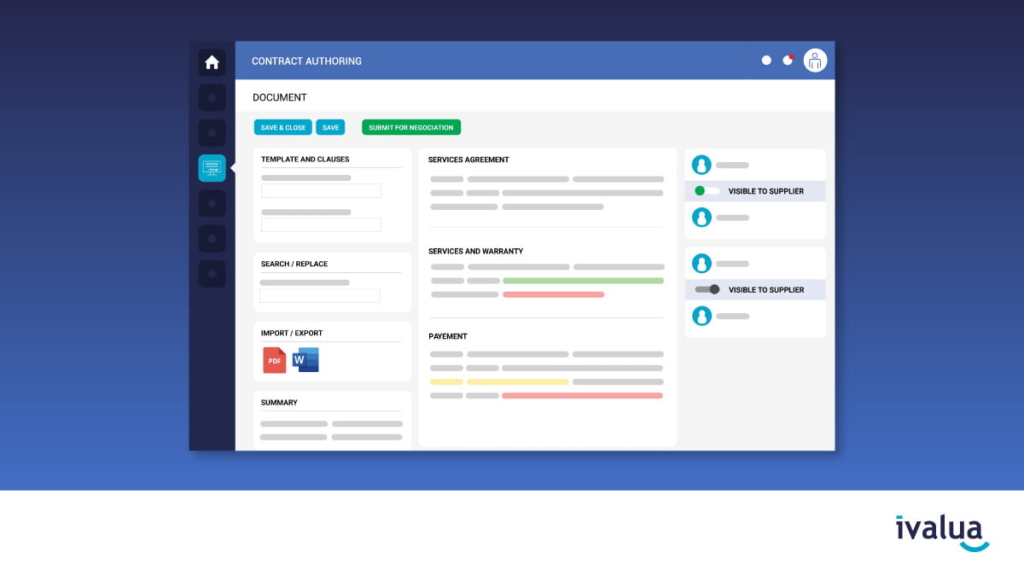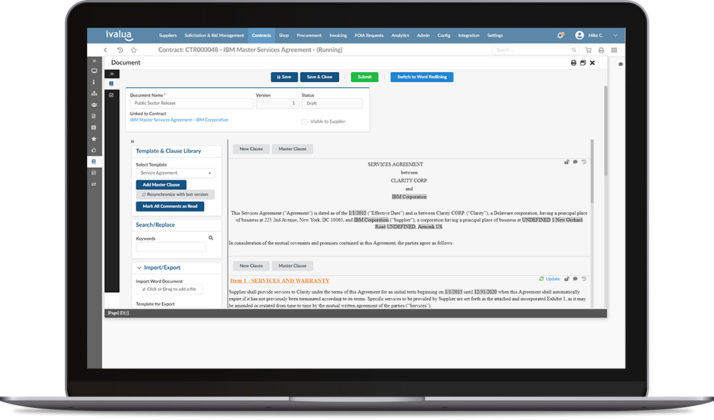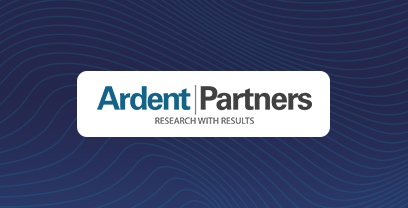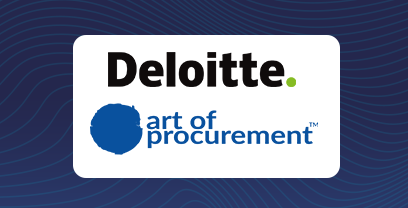Procurement leaders have an opportunity to move beyond the daily grind of disconnected systems and manual workarounds. In many organizations, sourcing, contracting, and supplier data still live in separate places, creating inefficiencies that slow progress. When procurement and contract management are fragmented, enforcing terms consistently or reconciling mismatched data can be time-consuming and difficult.
The good news is that modern teams are breaking through these barriers with integrated Source-to-Contract solutions. By bringing sourcing, contracting, and supplier management into one connected process, organizations can reduce friction, strengthen governance, and ensure compliance is built in from the start.
In this blog, we’ll explore how Source-to-Contract frameworks help procurement teams eliminate bottlenecks, accelerate cycle times, and elevate procurement and contract management into a true driver of enterprise value.
Key Takeaways
- Fragmented procurement and contract management workflows lead to compliance gaps, delayed cycles, and missed obligations, making integration essential.
- A unified Source-to-Contract model streamlines sourcing, contracting, and supplier management into one continuous process, reducing risk and accelerating value delivery.
- Modern platforms like Ivalua embed governance, automation, and visibility across the lifecycle, ensuring contracts drive both cost efficiency and compliance.
Procurement vs Contract Management – Key Differences
Procurement and contract management share the common goal of supporting organizational value, but they operate at different stages of the buy-side process and focus on distinct outcomes.
- Procurement is about acquisition – identifying the right suppliers, negotiating terms, and ensuring goods and services are obtained at the best cost, quality, and timeline. Its success is measured in metrics like cost savings, supplier lead times, and purchase order accuracy.
- Contract management begins once the deal is signed and focuses on execution and governance – drafting enforceable terms, monitoring compliance, and managing supplier performance. Its KPIs emphasize compliance, approval cycle time, and supplier performance scores.
Procurement teams rely on e-Procurement platforms and ERP systems to optimize sourcing, while contract management depends on CLM software and legal oversight to minimize legal and regulatory risk.
Together, they contribute value in complementary ways: procurement reduces costs and drives sourcing efficiency, while contract management ensures obligations are met and disputes avoided.
The table below highlights differences in scope, stakeholders, and tools.
| Attribute | Procurement | Contract Management |
| Primary Objective | Acquire goods and services at optimal cost, quality, and timeline | Ensure contractual obligations are met and relationships are managed |
| Scope | Supplier identification, evaluation, negotiation, and purchase order issuance | Contract drafting, execution, compliance monitoring, renewal, and closure |
| Timeline | Starts before contract signing and ends at purchase order fulfillment | Starts at contract signing and continues until renewal or termination |
| Key KPIs | Cost savings %, supplier lead time, purchase order accuracy | Contract compliance rate, cycle time to approval, supplier performance score |
| Stakeholders | Procurement officers, category managers, finance teams | Legal teams, contract managers, compliance officers |
| Tools & Systems | e-Procurement platforms, ERP systems | Contract Lifecycle Management (CLM) software, document repositories |
| Risk Focus | Supplier risk, pricing volatility, supply continuity | Legal risk, performance risk, regulatory compliance |
| Value Contribution | Reduces purchase costs, optimizes sourcing strategy | Reduces disputes, enables dispute resolution, increases operational efficiency, ensures compliance |
Bringing these disciplines closer together is key to achieving both cost efficiency and compliance continuity across the full lifecycle. In the next section, we’ll dig into why.
Why Procurement and Contract Management Must Be Unified
When procurement, contracting, and supplier oversight rely on different tools, teams, and data sources, you pay in inefficiency, risk, and lose value.
Fragmented workflows make contract enforcement reactive rather than proactive, and without centralized visibility, clauses can’t be enforced. You may miss renewals or not follow through with your contract obligations.
What’s more, supplier accountability suffers when performance metrics like delivery times, quality rates, and compliance with contract terms are scattered or tracked inconsistently. This makes it difficult to hold suppliers accountable for problems.
Finally, spend control erodes when purchasing falls outside of approved contracts, and costs go up because of expedited orders or unapproved changes.
These problems multiply in global, regulated environments, where there are overlapping jurisdictional rules, compliance mandates (e.g. data privacy, export controls, ESG), and currency or tariff fluctuations.
The NCMA/CMI 2024 General Survey Report found that procurement and contract management leaders face major hurdles in workforce development, compliance, inefficient processes, and uneven adoption of digital technologies like AI, ML, and RPA, highlighting the need for greater integration across the contract lifecycle.
Let’s take a closer look at these issues.
Disconnected Sourcing and Legal Processes Delay Execution
Too often, sourcing and legal teams operate on different systems, with different priorities, and on different timelines. Procurement may complete a competitive sourcing event quickly, only to have contracts stall once handed off to legal for drafting or review.
Without shared visibility or aligned workflows, teams may misunderstand key terms and conditions, or try to renegotiate terms. This frustrates suppliers and slows down time to value.
In global or highly regulated environments, this disconnect can also result in overlooking data privacy, export controls, or ESG requirements, because the sourcing team assumes the legal team will enforce them, and vice versa.
As a result of this disconnected workflow, you may experience longer cycle times and missed deadlines, and preventable risks slip into executed contracts. Rather than a smooth process, the sourcing-to-contract handoff turns into a bottleneck that slows progress and erodes efficiency gains.
Siloed Ownership Creates Accountability Gaps
Procurement may perform supplier relationship management day-to-day, but the actual contract terms often sit with the legal team, while financial enforcement sits with finance. This fragmented ownership can create a lot of confusion if obligations aren’t met.
For example, if deliveries arrive late, is it procurement’s role to escalate, or legal’s to enforce penalties? Or if scope creep occurs, procurement negotiates with the supplier, but legal may not be aware until the contract is already compromised. Finance may then dispute invoices without full context, further straining relationships.
These gaps make accountability murky, and issues drag on. To avoid such scenarios, you need a unified lifecycle owner – one role, process, or platform – that ties supplier engagement, contractual obligations, and financial accountability together.
In the next section, we’ll look at the full Source-to-Contract lifecycle and how all stages fit together.

A Unified Source-to-Contract Lifecycle Model
Here’s a structured way to show the entire lifecycle as one continuous loop — from upfront strategy through contract closure and renewal.
Using Source-to-Contract solutions, each stage connects to the next, with governance, role clarity, and data feedback loops ensuring efficient procurement processes.
- Stage 1 – Needs Identification: Procurement teams collaborate with business stakeholders to define requirements, budgets, and compliance needs. Clarity at this stage prevents scope creep later and sets the foundation for strategic sourcing decisions.
- Stage 2 – Supplier Selection: Category managers evaluate suppliers based on cost, capability, risk, and ESG performance. Transparent scoring models and due diligence ensure supplier choices align with organizational strategy.
- Stage 3 – Contract Drafting and Negotiation: Legal, procurement, and finance work together to build terms that balance cost, risk, and compliance. Standardized templates and playbooks streamline negotiations while protecting organizational interests.
- Stage 4 – Contract Execution: Once signed, contracts move into active use. Clear ownership ensures obligations such as delivery timelines, pricing structures, and service levels are communicated to all stakeholders, including suppliers.
- Stage 5 – Supplier Performance Monitoring: Procurement tracks KPIs such as compliance rate, supplier performance, and risk indicators. Automated alerts and dashboards highlight issues early, while supplier scorecards provide accountability.
- Stage 6 – Renewal or Termination: At contract end, organizations decide whether to renew, renegotiate, or terminate based on performance data and business priorities. Lessons learned feed back into the needs identification stage, creating a continuous improvement cycle.
By unifying these stages in one lifecycle framework, strategic sourcing software provides control, reduces risk, and turns contracts into drivers of long-term value.
Planning and Sourcing: Defining Strategic Needs Early
Effective sourcing begins long before suppliers submit proposals. It starts with getting clear on strategy, stakeholder alignment, and a category plan that drives contract strength.
At the planning stage, procurement works closely with business units, finance, legal, and compliance to define objectives, risk tolerances, desired service levels, and governance guardrails. When all stakeholders agree on priorities, procurement can tailor their sourcing strategy to embed those needs upfront.
A well-developed category strategy guides competitive evaluations, differentiating suppliers not just by price but by capabilities that support long-term objectives.
This enables stronger contract language, because negotiations begin with shared strategic sourcing goals. Sourcing decisions are backed by data, benchmarking, and cross-functional buy-in, reducing surprises during negotiation.
By anchoring contracts in the strategic sourcing process, organizations avoid chasing scope changes or adding clauses later as afterthoughts. Procurement and legal enter negotiations knowing which terms matter most, which risks must be mitigated, and which tradeoffs are acceptable. This alignment accelerates cycles and increases contract resilience.
Contract Award and Negotiation: Structuring for Performance
During negotiation and drafting, sourcing strategies are translated into enforceable agreements. Procurement and legal teams must align on commercial outcomes such as cost, service quality, innovation, and risk control and create contracts that clearly define performance obligations with measurable KPIs. Contracts should also include risk clauses that protect the organization from supply disruptions, pricing volatility, or non-compliance.
Adding in performance incentives such as bonus structures for exceeding service levels or penalties for late delivery can help reinforce accountability and encourage continuous improvement.
Be sure to give careful attention to renewal terms, which are sometimes overlooked, to ensure smoother transitions once the contract is up.
If your sourcing and legal teams collaborate effectively, negotiations can help balance opportunity with risk mitigation. They also set the stage for strong supplier relationships that deliver lasting value.
Post-Award Governance: Monitoring, Changes, and Enforcement
Once a contract is signed, contract administration begins. This includes: e
- Ensuring that all parties understand their obligations (e.g. delivery dates, quality, payment terms)
- Setting up internal ownership
- Establishing tools and workflows for tracking obligations
- Ongoing performance monitoring of KPIs and SLAs
Contract lifecycle management tools provide automated alerts for key obligations and milestones so that nothing important is overlooked. Data and dashboards enable real-time oversight, providing early warning if there’s a dip in performance to mitigate risk, help enforce accountability and enable continuous improvement.
When needs or circumstances change, scope changes or amendments may be necessary. All of the stakeholders should review the change requests, reassess terms, and document any approved changes. This helps prevent uncontrolled scope creep or informal amendments that can increase risk and erode value.
Finally, as contracts near expiration, renewals or termination become critical leverage points. Early alerts for renewal give time to review supplier performance, reassess market conditions, renegotiate terms (or choose a new supplier), or formally close out obligations.
Contract Execution: Operationalizing The Agreement
Once you finalize contract terms, internal approvals begin. Procurement, legal, finance, and business owners all sign off on obligations, budgets, and compliance requirements. This governance step prevents gaps in accountability and ensures that commitments reflect organizational priorities.
The next step is to set up suppliers in procurement and finance systems, with validated banking details, tax information, and performance expectations clearly documented. Onboarding also includes sharing contract obligations with operational teams so that everyone understands service levels, reporting requirements, and escalation paths.
It’s important to link the contract with e-procurement platforms, ERP, and supplier management tools through integrations. Having all tools talking to each other ensures purchase orders, invoices, and performance data are consistent and free of errors.
When you handle contract execution with discipline, you can avoid many of the disputes that can plague later stages, such as misaligned terms, missed payments, or unclear service levels. Aligning stakeholders and embedding contracts into workflows upfront creates a strong foundation for compliance and long-term success.
Post-Award Governance: Monitoring, Changes, And Enforcement
Once a contract is awarded, contract lifecycle management kicks in. By now, all parties should understand their responsibilities and managing obligations . Centralizing the contract in a repository and using automated alerts for milestones like payments, renewals, audits helps to ensure no obligations fall through the cracks.
At the same time, performance monitoring is a key part of supplier performance management, tracking delivery against agreed KPIs for quality, timeliness, and compliance with contractual and regulatory standards.
Using real-time dashboards and supplier scorecards enables you to detect any underperformance or risk early, and take action. Early detection of underperformance or risk. Integrated tools help to collect performance data, manage risk profiles, and maintain visibility over supplier compliance.
Renewal And Continuous Improvement: Extending Value Beyond Term
By the time a contract nears expiration, you should have a full record of supplier performance data and KPIs: on-time delivery, quality metrics, compliance adherence, and responsiveness to issues. This evidence provides a clear picture of whether a supplier has delivered value or fallen short.
Based on this insight, you can consider three main options.
- A straight extension may make sense if performance has been strong and business needs remain stable.
- Renegotiation is often warranted when market conditions, scope, or compliance requirements have changed, or when performance data indicates room for improvement.
- Termination and re-sourcing should be pursued if the supplier has consistently underperformed or if strategic priorities require a different partner.
The most effective organizations treat renewal as part of a continuous improvement loop. Lessons from contract monitoring feed directly into the next sourcing cycle, ensuring requirements, KPIs, and contract structures evolve alongside business needs.
By linking renewal decisions to performance and strategy, procurement teams can manage risk effectively and build stronger, more resilient supplier relationships over time.
But contract management in procurement doesn’t always go smoothly. In the next section, we examine various ways governance can fail and how to resolve problems when they occur.

Governance Breakpoints Across the Lifecycle
Here are several ways governance often fails, and how a procurement platform like Ivalua can provide stronger policy enforcement, real-time checkpoints, and automation to reduce risk.
- Lack of Budget Checks Before Award: Sometimes contracts are negotiated and awarded without thorough review of available budget. When finance isn’t looped in early, departments may agree to obligations they can’t afford. Without a real-time budget validation step built into approvals, overspending and cost overruns become likely.
- Missing Change Control Processes: Once a contract is live, scope changes or amendments are often made informally via email or side conversations, without updating the master contract. This leads to mismatched expectations, untracked liability, and disputes when one party believes a change was part of the deal, but it’s not documented.
- No Scorecard Discipline or Supplier KPIs: Even when performance metrics like quality, delivery, or compliance are well-defined, they are frequently not tracked or enforced. Without regular scorecard reviews and accountability, suppliers can underperform without consequences.
- Poor Visibility of Contracts: Contracts are stored in multiple places such as shared drives, email threads, or physical files, with no centralized repository. Key clauses or obligations are easy to lose or misinterpret, which also makes audits difficult.
- Inefficient Approval Cycles: When approvals are manual and routed through many stakeholders without clear roles or timelines, execution slows down. Delays cause missed deadlines, late supplier onboarding, or windows for renegotiation closing without being closed.
Here are some ways to mitigate these contract management pitfalls:
- Embedded finance sign-off early in the process ensures that no agreement moves forward without clear funding, protecting the organization from overspending and unexpected financial exposure.
- Institute a formal change-control workflow. Every modification should be documented, versioned, and approved by the right stakeholders. This discipline eliminates confusion over “informal” agreements made through side conversations and reduces the risk of disputes later.
- Reinforce supplier accountability through consistent scorecard use tracking key performance indicators (KPIs).
- Establish regular review cycles, such as quarterly performance meetings to address delivery issues, quality concerns, or compliance failures.
- Centralize contract information in a single repository that integrates with procurement and finance systems. This ensures visibility across teams, improves audit readiness, and makes it easy to monitor obligations in real time.
- Leverage automation to strengthen these measures further by enforcing approval thresholds, generating alerts for missed deadlines, and applying standardized clause libraries to new contracts.
Together, governance discipline and technology-enabled checkpoints reduce manual oversight risks, prevent disputes, and safeguard long-term supplier value.
Next we outline some essential best practices to include in your procurement strategy, to ensure effective contract management.
Operational Best Practices for Contract-Enforced Procurement
A strong procurement strategy provides the framework for contract-enforced procurement. The following practices will help you enforce governance, reduce risk, and drive long-term value for money across the contract lifecycle.
Standardizing Templates and Workflows
When every sourcing event or contract begins with an approved template, organizations avoid reinventing the wheel and ensure clauses, compliance language, and approval steps remain consistent.
Workflow automation extends this consistency globally by routing approvals through the correct stakeholders, regardless of geography or business unit.
For example, a standardized Master Services Agreement template with pre-approved risk clauses can cut weeks off the cycle by reducing the amount of back-and-forth with legal. Instead of each agreement requiring full legal review, legal teams focus only on exceptions, reducing backlog and accelerating supplier onboarding.
Using Category Management Strategies
Category management allows you to treat spend strategically by segmenting it into areas with shared supplier markets, risks, and business priorities.
Rather than applying a one-size-fits-all approach, teams develop category-specific strategies: IT sourcing may focus on innovation and cybersecurity risk, logistics on cost efficiency and continuity, and professional services on expertise and deliverables.
This segmentation ensures your suppliers are evaluated on the factors that truly matter for each category, and contract terms are crafted to reflect those priorities.
Applying Risk Management Frameworks
Structured contract risk management frameworks help procurement teams identify, score, and mitigate risks across financial stability, supplier performance, geopolitical uncertainty, and regulatory compliance. By embedding these frameworks throughout the contract lifecycle, you can address risk proactively.
For example, financial assessments during supplier onboarding can prevent failures down the line, while performance risk scoring tied to contract KPIs can trigger escalation before delivery delays occur.
Continuous monitoring and early-warning systems are essential since risks can change over time, and contracts must adapt accordingly. You should have escalation protocols in place so ownership for risk mitigation is clear.
Leveraging Contract Lifecycle Management (CLM) Software
Contract management software provides the governance backbone for large enterprises managing thousands of contracts across geographies and entities.
By digitizing drafting, approvals, performance management, and renewals, CLM enforces consistency and reduces reliance on manual oversight. CLM systems automatically route contracts to the right stakeholders and complete compliance checks, and they track obligations in real time, reducing cycle times and preventing audit failures.
Advanced features like AI-driven clause libraries and risk flagging enable you to identify non-standard terms or risky language in the contract before signing it. Ultimately, CLM tools allow you to scale governance without slowing down your business.
Use Role-Based Controls and Pre-Award Budget Checks
Governance can fail when contracts are awarded without proper validation. Role-based controls ensure that every agreement passes through finance, legal, risk, and procurement orchestration checkpoints before signing.
For example, pre-award budget checks can help prevent you from committing to spend that exceeds funding allocations or approved forecasts. Legal validations ensure obligations are enforceable, while risk assessments identify vulnerabilities before they become costly disputes.
Role-based workflows also clarify accountability. Every stakeholder knows their approval role and cannot be bypassed. By enforcing these checkpoints automatically, you can reduce disputes downstream and ensure that every contract is grounded in fiscal, legal, and operational discipline.
Tie Supplier Scorecards to Contractual Commitments
Performance indicators such as on-time delivery, product quality, and cost control should be embedded in contracts as measurable KPIs and evaluated on a regular cadence as part of supplier management.
When vendor scorecards and contracts are disconnected, suppliers can underperform without consequence, and you lose leverage in enforcement or renewal discussions.
Unified systems make this linkage possible by capturing supplier performance data in real time and aligning it with contract terms. This drives accountability and provides a factual basis for renegotiations, renewals, or other corrective actions.
Embedding Compliance Checks Throughout the Lifecycle
Don’t treat compliance management as a single event during contract drafting. Instead, embed checkpoints throughout the lifecycle, at drafting, execution, performance monitoring, and renewal.
In regulated industries such as healthcare, this might include ongoing HIPAA compliance; in financial services, it could involve anti-money laundering or data privacy obligations.
Automated compliance alerts ensure that you review and enforce all obligations at every stage, and reduce the risk of failing an audit or incurring penalties.
Establishing Change Control Protocols
Unmanaged change is one of the biggest drivers of disputes and spend leakage, which is why change orders and amendments should be routed through formal workflows with documentation, approvals, and traceability.
Scope creep is inevitable without this oversight, causing spiraling costs and confusion around contract terms. Integrated procurement systems can enforce change control by automatically tracking amendments, flagging deviations from contract baselines, and requiring cross-functional approvals, so that every modification is captured and auditable.
Stakeholder Engagement and Role Clarity
Fragmented handoffs between procurement, legal, finance, and business owners often create delays and accountability gaps. However, when you engage stakeholders early and clarify roles, everyone understands their responsibilities throughout the lifecycle.
For example, governance checkpoints may require cross-functional signoff before executing a high-value contract. That way budget validation, compliance language, and performance clauses are all aligned.
Clarifying roles ahead of time prevents duplication of effort, reduces cycle delays, and ensures that when disputes arise, ownership is clear. That makes for much smoother execution, and contract management becomes a collaborative effort across the organization.
Next, we explore how the right procurement platform can operationalize and simplify contract management, enabling you to more easily implement all of these best practices.
Technology in Procurement and Contract Management
Procurement technology has become the backbone of modern procurement and contract management, transforming workflows that were once manual, fragmented, and error-prone. By embedding digital tools across the lifecycle, enterprise procurement teams gain speed, visibility, and control:
- Automation eliminates repetitive tasks such as approvals, reminders, and obligation tracking, reducing cycle times and freeing teams to focus on strategic sourcing decisions.
- Integration ensures that procurement, legal, and finance all work from the same data, creating a single source of truth that reduces rework and audit risk.
- AI in procurement unlocks new capabilities in risk detection, clause standardization, and performance monitoring, allowing organizations to manage complexity at scale.
For large enterprises operating across multiple entities and regulatory environments, the impact is significant. Contracts can be drafted, reviewed, executed, and monitored in a fraction of the time, with automated compliance checkpoints ensuring nothing slips through. Plus, supplier data flows seamlessly from sourcing to contracting to payment, minimizing mismatches and disputes.
By unifying these functions under a Source-to-Contract model, you can align sourcing outcomes with contractual performance and capture more value. In the following sections, we explain how.
Role of AI in Contract Review
AI tools are revolutionizing the way contracts are reviewed. Modern AI engines can scan contracts to identify non-standard clauses, flag high-risk language, and suggest alternative text drawn from approved clause libraries.
They accelerate legal review cycles because they enable you to focus on what needs attention, cutting days or weeks from contract approval timelines.
Practical applications are already widespread:
- Clause libraries ensure consistency across agreements.
- Risk scoring models provide an instant snapshot of contractual exposure.
- Obligation extraction automatically maps key deliverables, timelines, and renewal dates into monitoring systems, reducing the risk of missed commitments.
For procurement leaders, AI helps to ensure compliance and provide confidence that every contract reflects organizational standards.
Automation of Approval Workflows
Approval bottlenecks are a common cause of contract delays, particularly in enterprises spanning multiple geographies and business units. Automated workflows replace manual routing with configurable approval rules based on spend thresholds, contract type, or risk category. As a result, the right people review the right contracts at the right time.
For example, a high-value IT outsourcing contract may automatically route to procurement, legal, and finance executives, while a low-risk renewal might only require category manager approval.
Automated reminders and escalations prevent contracts from stalling in inboxes, as well. Plus, they leave an audit trail. By aligning governance with automation, you can eliminate friction while staying in control.
Integration with ERP Systems
Integrating procurement and contract management systems with ERP platforms creates a seamless single source of truth for enterprise operations.
You can run real-time budget checks during contracting to ensure funds are available prior to making a commitment, and supplier data stays in sync across sourcing, contracting, and finance, reducing duplication and errors.
When systems are integrated, you can even use automated workflows to convert purchase requisitions (PRs) into purchase orders (POs) once the contracts are executed.
Integration also strengthens audit readiness, since you can maintain consistent records across systems.
For example, when a logistics contract is signed, pricing and supplier terms automatically update in the ERP, allowing finance to reconcile invoices against the correct benchmarks. Legal, procurement, and finance all gain visibility into the same data, making governance more transparent and reducing disputes.
Legal and Compliance Considerations
Procurement and the contract management process can’t operate in isolation from the broader legal and regulatory environment. Every agreement must align with standards and frameworks that safeguard quality, ethics, and compliance.
For many enterprises, ISO standards provide a baseline. ISO 9001 emphasizes quality management, while ISO 20400 guides sustainable procurement practices. Embedding these standards into sourcing and contract terms helps ensure consistency across global operations.
Equally important are industry-specific regulations, which can set the guardrails for contract language and enforcement. In finance, for instance, strict rules around anti-money laundering and risk disclosures apply. Healthcare organizations must account for HIPAA requirements and patient data security.
Government contracts are subject to Federal Acquisition Regulation (FAR) and other compliance mandates that dictate not only terms but also reporting obligations.
Regional regulations also play a role. For example, data privacy regulations such as GDPR in Europe and CCPA in California now play a central role in contract negotiations. Clauses around data usage, storage, and breach notification are non-negotiable in agreements where personal information is processed. In the UK, the Procurement Act in the UK reforms public sector procurement by simplifying rules, promoting transparency, and ensuring better value and fair competition in how government contracts are awarded and managed.
Failure to incorporate these rules into contracts exposes organizations to both legal and reputational risk. To mitigate that risk, it’s important to work closely with legal teams and IT security to ensure you capture and monitor these obligations over the contract’s lifecycle.
One Ivalua customer, UPL, was able to scale effectively through a period of growth while maintaining compliance. Let’s dive into this real-world case study.
Customer Story: How UPL Achieved 100% PR‑PO Adoption and Margin Gains
UPL, one of the world’s largest agrochemical companies with products in over 150 countries and more than 10,000 employees, wanted to centralize procurement to gain visibility, control, and economies of scale.
UPL began its implementation of Ivalu in India, focusing on direct materials, where it achieved 100% PR-to-PO compliance within nine months. Automated pricing compliance on direct materials delivered measurable margin gains, while SAP integrations enabled real-time budget checks, strengthening governance and financial discipline.
UPL’s global rollout of Ivalua following the acquisition of Arysta LifeScience in 2019 positioned the company as the fifth-largest generic agrochemical player worldwide. By the end of 2023, UPL had deployed Ivalua across all 43 of its manufacturing sites globally, unifying procurement and sourcing through a single platform.
“The biggest benefit is having a single source of truth in one centralized platform. With strategic sourcing and transactional procurement on one platform globally, we benefitted from scale and efficiency.”
– Sylesh Gopan, Global ERP Head at UPL
This “single source of truth” improved collaboration, standardized processes, and ensured consistent compliance across regions.
Unify Lifecycle Oversight to Unlock Strategic Value
Procurement and contract management can no longer operate as separate disciplines. When sourcing outcomes and contractual obligations are disconnected, risk rises and value decreases. A unified Source-to-Contract solution approach brings these functions together, ensuring transparency, accountability, and continuous improvement across the lifecycle.
With a modern procurement platform like Ivalua, you can embed governance, automate workflows, and align your global teams.
Unify Procurement and Contracts With Ivalua’s Source-to-Contract Solution
FAQs
Procurement focuses on acquiring goods and services at the best cost, quality, and timeline, while the contract management process ensures obligations are met after signing. For example, procurement might source IT services, while contract management oversees SaaS agreements to ensure compliance, performance, and renewals.
Procurement is the process of identifying needs, selecting suppliers, and negotiating purchases. Contract management begins after signing and ensures terms are enforced, performance is tracked, and renewals or terminations are managed. Together, they form a continuous cycle: procurement can secure value upfront, while contract management preserves it over time.…
When procurement and legal share a single platform, contract cycles move faster, compliance gaps shrink, and obligations don’t slip through the cracks. This alignment ensures terms negotiated with suppliers are accurately captured and enforced throughout the contract lifecycle.
The lifecycle of procurement contract management spans from needs identification and supplier selection through contract drafting, execution, performance monitoring, and renewal or termination. Each stage builds on the last, with governance and feedback loops driving continuous improvement.
Technology centralizes contracts, automates alerts, and embeds compliance checks into workflows. This reduces the chance of missed obligations, enforces approvals, and provides real-time visibility into supplier performance.
A solid plan outlines roles, responsibilities, key terms, performance metrics, risk controls, and renewal procedures. It acts as a roadmap for enforcing obligations and measuring value throughout the contract lifecycle.
By tracking KPIs, monitoring compliance, and enforcing performance obligations, contract management surfaces risks before they escalate. It ensures suppliers are accountable for timelines, quality, and regulatory requirements.
A Contract Lifecycle Management (CLM) system digitizes drafting, execution, and monitoring, creating one source of truth for contracts. It reduces cycle times, improves compliance, and enables organizations to manage risk and value more effectively.

















